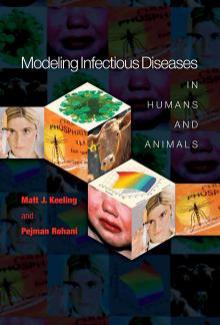Modeling Infectious Diseases in Humans and Animals 1st edition by Matt Keeling, Pejman Rohani ISBN 9781400841035 1400841038
$70.00 Original price was: $70.00.$35.00Current price is: $35.00.
Instant download Modeling Infectious Diseases in Humans and Animals after payment
SKU: EB_95832
Category: Ebooks
Modeling Infectious Diseases in Humans and Animals 1st edition by Matt Keeling, Pejman Rohani – Ebook PDF Instant Download/Delivery: 9781400841035, 1400841038
Full download Modeling Infectious Diseases in Humans and Animals 1st edition after payment

Product details:
ISBN 10: 1400841038
ISBN 13: 9781400841035
Author: Matt J. Keeling; Pejman Rohani
Modeling Infectious Diseases in Humans and Animals
For epidemiologists, evolutionary biologists, and health-care professionals, real-time and predictive modeling of infectious disease is of growing importance. This book provides a timely and comprehensive introduction to the modeling of infectious diseases in humans and animals, focusing on recent developments as well as more traditional approaches. Matt Keeling and Pejman Rohani move from modeling with simple differential equations to more recent, complex models, where spatial structure, seasonal “forcing,” or stochasticity influence the dynamics, and where computer simulation needs to be used to generate theory. In each of the eight chapters, they deal with a specific modeling approach or set of techniques designed to capture a particular biological factor. They illustrate the methodology used with examples from recent research literature on human and infectious disease modeling, showing how such techniques can be used in practice. Diseases considered include BSE, foot-and-mouth, HIV, measles, rubella, smallpox, and West Nile virus, among others. Particular attention is given throughout the book to the development of practical models, useful both as predictive tools and as a means to understand fundamental epidemiological processes. To emphasize this approach, the last chapter is dedicated to modeling and understanding the control of diseases through vaccination, quarantine, or culling. Comprehensive, practical introduction to infectious disease modeling Builds from simple to complex predictive models Models and methodology fully supported by examples drawn from research literature Practical models aid students’ understanding of fundamental epidemiological processes For many of the models presented, the authors provide accompanying programs written in Java, C, Fortran, and MATLAB In-depth treatment of role of modeling in understanding disease control
Modeling Infectious Diseases in Humans and Animals 1st Table of contents:
Chapter 1: Introduction to Mathematical Models in Disease Dynamics
- 1.1-1.3: Defines disease types, characterizes infectious diseases, and explains the importance of controlling them.
- 1.4-1.5: Introduces mathematical models and discusses what they can do (predict behaviors, simulate scenarios) and cannot do (account for all complexities).
- 1.6-1.7: Discusses what makes a good model (accuracy, simplicity, practicality) and introduces the layout of the book.
- 1.8-1.9: Provides an overview of the book’s structure and what background knowledge might be needed.
Chapter 2: Introduction to Simple Epidemic Models
- SIR Models: Focuses on the basic SIR (Susceptible-Infected-Recovered) model, both with and without demography (population changes).
- Threshold Phenomenon and Epidemic Burnout: Explains key dynamics of epidemic growth and decline.
- Worked examples (e.g., influenza in a boarding school) illustrate the practical use of these models.
- Variants: Covers models with mortality, immunity (SIS, SIRS), latent periods (SEIR), and those with carriers.
- Parameterization: Discusses how to estimate the basic reproduction number (R0) from various types of data.
Chapter 3: Host Heterogeneities
- Risk-Structure Models: Discusses sexually transmitted infections (STIs), using the example of HIV and koalas, and how population heterogeneity affects disease dynamics.
- Age-Structure Models: Focuses on childhood infections like measles, and the impact of age-specific susceptibility.
- Dependence on Time Since Infection: Explores models that consider how infection history affects disease transmission (e.g., SARS).
- Future Directions: Looks at emerging research on host heterogeneity and disease modeling.
Chapter 4: Multi-Pathogen/Multi-Host Models
- Multiple Pathogens: Explores interactions between different pathogens (e.g., measles and whooping cough) and the concept of cross-immunity.
- Multiple Hosts: Discusses diseases that affect multiple host species (e.g., foot-and-mouth disease) and zoonoses (diseases transmitted from animals to humans, such as West Nile virus).
- Evolutionary Implications: Considers how these interactions influence pathogen evolution.
- Future Directions: Discusses the need for more complex models to handle multi-pathogen and multi-host interactions.
Chapter 5: Temporally Forced Models
- Seasonality: Investigates how diseases like measles exhibit seasonal patterns, driven by environmental factors or human behavior.
- Multi-Annual Cycles: Looks at diseases that experience periodic outbreaks.
- Dynamical Transitions: Explores shifts in disease dynamics under seasonal forcing.
- Application: Studies include childhood infections and wildlife diseases, such as rabbit hemorrhagic disease.
Chapter 6: Stochastic Dynamics
- Noise in Models: Examines how observational and process noise (random fluctuations) affect disease dynamics.
- Stochastic Extinctions: Explores the concept of critical community size and the role of stochasticity in disease persistence.
- Simulation: Discusses event-driven simulations and their applications (e.g., porcine reproductive syndrome).
- Individual-Based Models: Covers how individual-level data can be used to model disease spread more accurately.
- Future Directions: Emphasizes the need for models that can better capture real-world randomness.
Chapter 7: Spatial Models
- Concepts: Introduces key spatial dynamics concepts like heterogeneity, interaction, isolation, and localized extinction.
- Metapopulations: Discusses how diseases spread across geographically separate populations (e.g., wildlife diseases like rabies).
- Lattice-Based and Cellular Automata Models: Simulates disease spread on grids or networks.
- Continuous-Space Models: Uses reaction-diffusion equations to model the spread of disease in continuous space.
- Networks: Investigates the role of networks (e.g., social or transportation networks) in disease transmission.
Chapter 8: Controlling Infectious Diseases
- Vaccination: Discusses various vaccination strategies, including pediatric and wildlife vaccination, imperfect vaccines, pulse vaccination, and age-structured vaccination.
- Contact Tracing: Explores methods of isolating infected individuals and tracing contacts to control outbreaks.
- Case Studies: Includes examples of successful disease control measures, such as smallpox eradication, foot-and-mouth disease management, and swine fever virus control.
- Future Directions: Looks ahead to new techniques and strategies for controlling infectious diseases.
People also search for Modeling Infectious Diseases in Humans and Animals 1st:
modeling disease transmission lab
modeling infectious diseases in humans and animals princeton university press
modelling infectious diseases in humans and animals
what diseases do animals and humans have in common
why are animal models important for understanding human diseases


